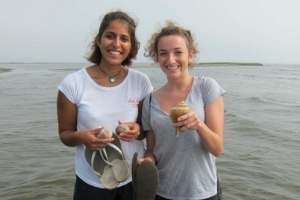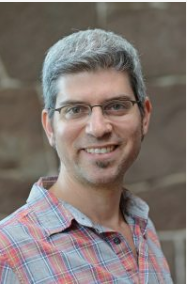 A conversation with Professor Michael Singer, Professor of Biology and Environmental Studies, about his Fall 2019 course BIOL 220/ENVS220: Conservation Biology. The course is a broad introduction to the interdisciplinary, science-based field of conservation biology. While the course includes aspects of economics, politics, ethics, and other fields, it focuses on the biological part of conservation. Much of this biology is ecology, which is Singer’s specialty. At left: BIOL220/ENVS220 students and visitor Dr. Paul Spitzer on a field trip earlier this semester.
A conversation with Professor Michael Singer, Professor of Biology and Environmental Studies, about his Fall 2019 course BIOL 220/ENVS220: Conservation Biology. The course is a broad introduction to the interdisciplinary, science-based field of conservation biology. While the course includes aspects of economics, politics, ethics, and other fields, it focuses on the biological part of conservation. Much of this biology is ecology, which is Singer’s specialty. At left: BIOL220/ENVS220 students and visitor Dr. Paul Spitzer on a field trip earlier this semester.
Can you briefly describe the course? What is its goal?
A major goal of the course is helping students understand in detail how human activities have destroyed biodiversity and changed ecosystems (including global climate), how such activities continue to threaten biodiversity and ecosystems, and how conservation biology is applied to develop solutions to these problems. It is only by understanding the problems that we can find meaningful solutions. With many examples from the scientific literature, students have a chance to dig into the details and think critically about the science and its implications. One of take-aways from the course is that constructive action to solve these problems requires cooperation among scientists, governments, private organizations, and the public. Sometimes I’ve encountered the misconception among students that scientists are mainly in charge of conservation efforts. While there are examples of maverick scientists running the show, in most cases scientists do the research and governments and NGOs run conservation programs, which are many and varied in size, scope, and aim.

Why do you think it’s an important course to be taught at Wesleyan?
Conservation Biology fills a gap in the curriculum. Many Wesleyan students are interested in environmental issues and there are various courses in the curriculum that address environmental issues. However, a scientific perspective is lacking in many of these courses even though science is a fundamental source of knowledge informing all environmental issues. The practice of environmental conservation, in particular, requires an ecological perspective, among others. I often get the impression that there are a lot of misconceptions about the role of science and scientists in environmental issues.
Why did you choose to invite Dr. Paul Spitzer ’68 to Wesleyan, and what is his involvement with the course? What is the intended effect of the field trips for the students?
Dr. Spitzer is a Wesleyan alum (Class of 1968) and has been wanting to reconnect with his alma mater. As a fellow ecologist, he introduced himself to me during a campus visit several years ago. I could see that Dr. Spitzer and his non-traditional career experience had a lot to offer my students. At my invitation, he first co-led a field trip to the Connecticut River Estuary for my Conservation Biology course back in 2013. The students loved it! Dr. Spitzer’s intimate knowledge of the area, its natural history, ecology, and human context, gave so much depth to the experience. He’s especially knowledgeable about the osprey and other birds along the shore, and students had a chance to see much more of the lives of those amazing animals than they would have seen without Dr. Spitzer’s help. Having such a guide while being outside is an invaluable and multidimensional educational experience for students.
Last year Dr. Spitzer approached me about doing a bit more than helping with a single field trip in my course. We wrote a proposal and the COE granted some funds that would enable Dr. Spitzer to contribute his expertise to lead additional field trips (two for my Conservation Biology course) as well as two seminars for the Wesleyan community. We really wanted to give students and broader Wesleyan community more access to him as a resource. He already gave one talk on the osprey this semester and will give another on the common loon (Oct. 3), the subject of a book manuscript he is writing. Dr. Spitzer’s approach to his seminars and field trips is very much in the tradition of liberal arts education, valuing both the poetry and science of the natural world. As an occasional visitor to my Conservation Biology class sessions this semester, Dr. Spitzer shares his experience and knowledge with concrete examples. His personalized contributions complement the theoretical content of the course.
Why are you a faculty member of the College of the Environment? How do the COE’s interdisciplinary values impact your work in other departments, and how does that work relate to the COE?
I am a faculty member of the COE because I am deeply interested in the environment and concerned about its future. My teaching and research (as well as my personal life) focus on environmental biology, so being part of the COE is a natural fit. The interdisciplinarity of the COE gives me a chance to see other disciplinary perspectives on environmental topics and interact with a broader range of students than I typically see in my science courses. In this spirit, I have occasionally collaborated with Wesleyan professors in other fields and contributed to some of their courses. Fortunately, the COE offers funding and a structure for doing that.